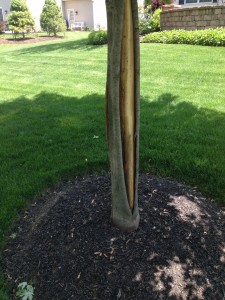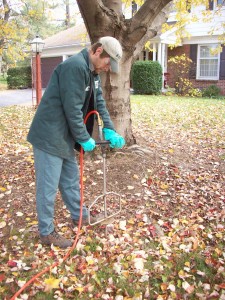 Why is there a crack or splitting tree on my property?
Why is there a crack or splitting tree on my property?
That’s a common question we get as Certified Arborists. This is a common issue with many varieties of trees and is typically noticed early in a tree’s life. Trees with thinner bark will typically have more splits and cracks naturally occurring. Bark splitting and cracking often results from a number of environmental factors. This is not to be confused with bark “sloughing.”
Sloughing occurs when a tree’s bark will change its texture as it ages and peel or “slough” off. This sometimes appears like exfoliating all over the trunk. What we’re talking about is defined cracks or splits in the bark.
What causes this?
The most common cause for splitting tree bark is from frost cracking or “sun scald.” Sun Scald most often occurs on the south to southwest side of tree trunks on young trees with thin bark. On a warm winter days, the direct sun’s heat warms up the surface of the bark. Later that night, these areas rapidly re-freeze. It’s this expansion and contraction of plant cells that cause cracks to burst open internally in the tree. The injuries are typically not visible until that following spring or even several seasons later. These slightly sunken, discolored areas start to lose bark from the decaying tissue.
Small frost cracks don’t typically cause serious damage to trees. However, they can provide openings where certain disease organisms may enter. This is especially true if the tree is in a weakened condition. Frost cracks are also the common nesting spot of insects. Not all of theses insects will feed on the tree, but will use these areas strictly as a home. Large cracks can cause problems for trees, particularly when it increases the hazard potential of a tree that is close to a potential target.
Can I do anything about it?
 Sun Scald and frost cracks are all but impossible to prevent. Some property owners have had limited success with wrapping the trunks of young trees with reflective, white paper in the late fall to help insulate the tree better. These wrappings should be removed immediately in spring so not to hold moisture against the trunk and attract insects. It is also important to prevent substantial damage from frost cracks by promoting good growth throughout the tree’s life, particularly when it is young. Be sure to water your young tree in times of drought and also fertilize trees annually.
Sun Scald and frost cracks are all but impossible to prevent. Some property owners have had limited success with wrapping the trunks of young trees with reflective, white paper in the late fall to help insulate the tree better. These wrappings should be removed immediately in spring so not to hold moisture against the trunk and attract insects. It is also important to prevent substantial damage from frost cracks by promoting good growth throughout the tree’s life, particularly when it is young. Be sure to water your young tree in times of drought and also fertilize trees annually.
If you find damage from frost cracking, remove any loose hanging bark. Use a sharp knife or wood chisel to give a clean cut to the wound area so the dead bark is not impeding the growth of the callous or “wound wood” that will grow to attempt to compartmentalize the decay of the wound. This operation can be performed by a local tree service that employs Certified Arborists if you are unable to do so or not confident in your abilities.
If you have cracks or splitting in trees on your property we would be happy to discuss their impact on your tree’s health. Please don’t hesitate to contact us for a free consultation for your trees.

